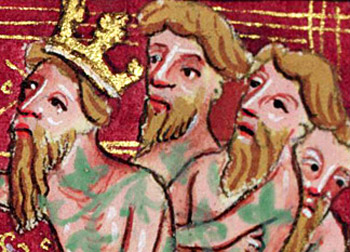Wedding of Sir Gawain and Dame Ragnelle
General Information
Plot Summary

Arthur returns to Carlisle and tells Gawain about Sir Gromer’s challenge. At Gawain’s suggestion, the pair separates and rides through the country, collecting answers in a book. With a month to go, Arthur returns to Ingleswood and meets a monstrously ugly woman, Dame Ragnell. She promises to give Arthur the correct answer, on the condition that he marries her to Sir Gawain. Arthur reluctantly consults Gawain, who agrees because of his love for the king. Arthur returns to the forest once more, where Ragnell tells him that all women want ‘sovereignty’.
When the year is up, Arthur returns to Sir Gromer and gives him his answer. The knight curses Ragnell, his sister, for helping the king, but has to admit that he is right. Ragnell returns to Carlisle with Arthur and insists on a lavish marriage in front of the whole court. Everyone marvels at her ugliness as she devours the splendid wedding banquet. [The couple retire] and Ragnell rebukes Gawain for his lack of sexual desire. He turns to find his wife transformed into a beautiful woman. She offers him a choice: she can be beautiful either at night or during the day. Gawain cannot decide, and tells his wife to make the decision. Delighted, she informs him that he has broken an enchantment placed on her by her stepmother: now that the best knight in England has given her sovereignty, she can be beautiful all the time. The couple go to bed.
When Arthur checks on Gawain the next day, the knight shows him his beautiful wife. The king rejoices, and tells the court about Sir Gromer. Ragnell promises to obey Gawain in all things, and asks Arthur to be good to her brother; everyone agrees that she is the fairest lady at the court. She and Gawain have a son, Gyngolyn, and live in perfect harmony for five years until she dies. The poem concludes with a prayer that its author be released from prison.
From: Donald Sands, Middle English Verse Romances. Exeter: University of Exeter Press, 1986.
Manuscript: Oxford, Bodleian Library, MS Rawlinson C. 86
Manuscripts
Click a title below to search for all romances in that manuscript.